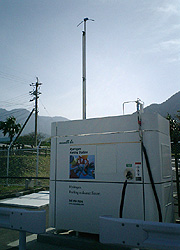Honda FC Stack-equipped FCX Fuel Cell Vehicle Test Drives to Begin on Yakushima
April 5, 2004, Japan
April 5, 2004—Honda Motor Co., Ltd. today announced that Honda R&D Co., Ltd. (President Takanobu Ito) will participate in a series of test drives of the Honda FC Stack-equipped FCX on Yakushima island in southern Japan. The test drives will be conducted as part of the Yakushima Zero Emissions Project, a joint research endeavor led by Honda R&D, an inter-university team led by Kagoshima University (President Yukihiro Nagata) and Yakushima Denko Co., Ltd. (President Hiroshi Ishii). The highly compact, high-output Honda FC Stack gives the FCX fuel cell vehicle the capability of starting at temperatures as low as -20ºC. The test drives are scheduled to begin in late April.
Currently engaged in testing of an energy self-sufficient system, the Yakushima Zero Emissions Project team is working to create a model for a recycling-based society. Sharing the project team’s goals, Honda R&D is participating with the dual aim of helping to protect the precious natural heritage of Yakushima and of progressing toward more environment-friendly energy production. In the context of the inter-university project team’s research into the introduction of hydrogen fuel, Honda will handle the test drives, and Yakushima Denko Co., Ltd. will take care of the operation and maintenance of the Hydrogen Station, which will be used in the test drives.
Under commission from Kagoshima University, Yakushima Denko Co., Ltd. finished work in late March on a Hydrogen Station, which uses electricity to generate hydrogen without carbon dioxide emissions. Making appropriate use of the abundant local water resources, the system is designed as equipment for a completely recycling-based society, and began operation in late April. Jointly testing the Honda FC Stack-equipped FCX and the Hydrogen Station, Honda and its partners in this venture are taking another step toward the realization of a recycling-based hydrogen-fueled society.
The Honda FC Stack is the world's first fuel stack to feature a stamped metal separator structure and newly developed electrolyte membranes. Conventional fuel cell stacks have a complex structure in which carbon separators are fastened together with bolts. The Honda FC Stack, however, has a simplified structure composed of stamped metal separators, with rubber seals that are attached in a unique molding process and enclosed by panels. This reduces the number of components by almost 50% (compared to a conventional unit1) and more than doubles the output density2, resulting in world-leading high performance. Further, use of newly developed aromatic electrolyte membranes greatly improves durability and allows for power generation at temperatures ranging from -20ºC(-4ºF) to +95ºC(+203ºF)-which would be a difficult achievement for stacks that employ conventional fluorine electrolyte membranes. The driving range of the FCX with a Honda FC Stack also has increased by 40 km3, from 355 km to 395 km, while fuel economy has improved by over 10%4.
- 1.Honda fuel cell stack on the FCX-V3
- 2.output/volume, output/weight
- 3.LA4 mode Honda in-house calculations
- 4.Compared with an FCX equipped with a Ballard fuel cell stack

Yakushima Hydrogen Station

Honda FC Stack-equipped FCX
Specifications of the Honda FC Stack-equipped FCX
| Name | FCX | |
| Number of occupants | 4 | |
| Max. speed | 150 km/h | |
| Motor | Max. output | 80kW (109PS) |
| Max. drive torque |
272N·m(27.5kg·m) | |
| Type | AC synchronous electric motor (manufactured by Honda) |
|
| Fuel cell stack (2 units) |
Type | PEMFC (proton exchange membrane fuel cell, manufactured by Honda) |
| Output | 86kW | |
| Fuel | Type | Compressed hydrogen |
| Storage | High-pressure hydrogen tank (350 atmospheres) |
|
| Capacity | 156.6 liters | |
| Dimensions (L x W x Hmm) | 4165 x 1760 x 1645 | |
| Energy storage | Ultra capacitor (manufactured by Honda) |
|
| Vehicle range (LA4 mode) | 395km | |